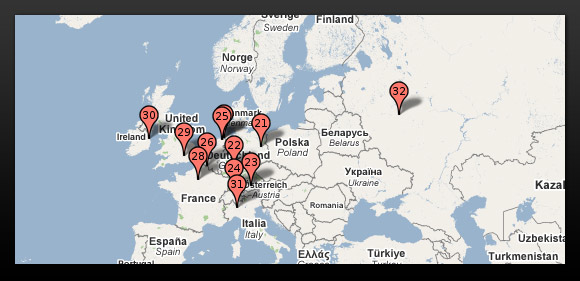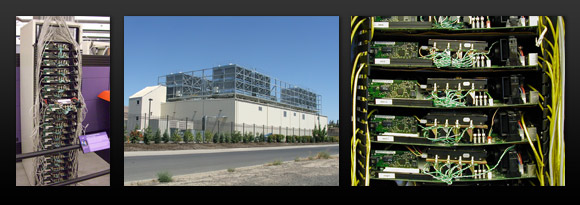So how many data centers do Google use, and where are they?
Google data center locations
If you include data centers that are under construction, Google has 19 locations in the US where they operate data centers, 12 in Europe, one in Russia, one in South America, and three in Asia. Not all of the locations are dedicated Google data centers, since they sometimes lease space in other companies’ data centers.
Above: Google data centers world wide.

Above: Google data centers in the USA.

Above: Google data centers in Europe.
We have created a map you can explore over at Wayfaring.
How much does Google spend on data centers?
According to Google’s earnings reports, they spent $1.9 billion on data centers in 2006, and $2.4 billion in 2007.Google unveiled four new data center projects in 2007. Each has a cost estimate of $600 million, which will include everything from construction to equipment and computers.
Google’s criteria when selecting locations for data centers
- Large volumes of cheap electricity.
- Green energy. Focuses on renewable power sources.
- Proximity to rivers and lakes. They use a large amount of water for cooling purposes.
- Large areas of land. Allows for more privacy and security.
- The distance to other Google data centers (for fast connections between data centers).
- Tax incentives.

Above left: Google’s first production server. Above middle: Google’s The Dalles data center in Oregon. Above right: Close-up of a Google server rack.
What’s up next?
Google has been looking at sites in Asia, such as Taiwan and Malaysia. There are also reports of a possible data center in Lithuania (Eastern Europe). Google is even more secretive about their US locations, but they have bought 466 acres of land in Blythewood, South Carolina.Google secrecy
Google has made it difficult both to find out where they keep their data centers and how many they have. One big reason for this is that almost all IP addresses that Google uses (and there are a lot of them) are listed to their Mountain View, California address, so just looking at IP addresses (with IP WHOIS or IP-to-location databases) won’t help you figure out where their data centers are or how many they have.In addition to this, Google usually seeks permits for their data center projects using companies (LLCs) that don’t mention Google at all, for example Lapis LLC in North Carolina and Tetra LLC in Iowa.
Since Google tends to be quite secretive about their data centers in general, the information we have presented here most likely isn’t 100% complete.
















